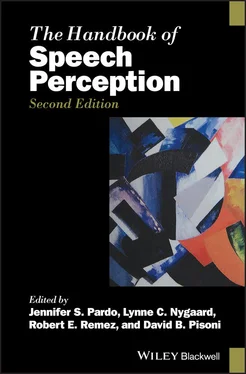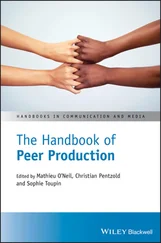Results of the passive listening task replicated Mesgarani et al.’s (2014) findings, showing selective responses in the superior temporal gyrus (STG) to manner of articulation as a function of manner of articulation, that is, the stop consonants clustered together and the fricative consonants clustered together. Of importance, a similar pattern emerged in the vSMC: neural activity clustered in terms of manner of articulation, although interestingly the consonants within each cluster did not group as closely as the clusters that emerged in the STG. Thus, frontal areas are indeed activated in speech perception; however, this activation appears to correspond to the acoustic representation of speech extracted from the auditory input rather than being a transformation of the auditory input to articulatory, motor, or gestural representations. While only preliminary, these neural findings suggest that the perceptual representation of features, even in motor areas, are acoustic or auditory in nature, not articulatory or motor. These results are preliminary but provocative. Additional research is required to examine neural responses in frontal areas to auditory speech input to the full consonant inventory across vowel contexts, phonetic position, and speakers. The question is: When consonant, vowel, or speaker variability is increased in the auditory input, will neural responses in frontal areas pattern with spectral and temporal features or gestural features.
This chapter has examined the role of features in speech perception and auditory word recognition. As described, while features have generally been considered representational units in speech perception, there has been a lack of consensus about the nature of the feature representations themselves. In our view, one of the major conflicts in current theories of speech has its roots in whether researchers have focused on identifying the attributes that define the phonetic categories of speech or, alternatively, have focused on characterizing the ways in which contextual factors can influence the boundaries between phonetic categories (see Samuel, 1982). In the former, the emphasis has been on describing the acoustic‐articulatory structure of phonetic categories in the latter, the emphasis has been on characterizing the ways in which acoustic changes ultimately affect the perception of boundaries between phonetic categories. These different emphases have also resulted in different conclusions. Studies focusing on the boundaries between phonetic segments have documented the ease with which boundary shifts have been obtained consequent to any number of acoustic manipulations, and as such the conclusion has been that there is no stable pattern of acoustic information that corresponds to these categories. Analyses of the acoustic characteristics of speech have produced mixed results. Focusing on individual cues and considering them as distinct events failed to show stable acoustic patterns associated with these cues. In contrast, focusing on the integration of spectral‐temporal properties revealed more generalized patterns or properties which contribute to the identification of a phonetic segment or phonetic feature.
So what is the story? Does acoustic invariance obviate variability? Does variability trump invariance? In both cases, we believe not. Both stable acoustic patterns and variability inherent in the speech stream play a critical role in speech perception and word recognition processes. Invariant acoustic patterns corresponding to features allow for stability in perception. As such, features serve as essential building blocks for the speaker‐hearer in processing the sounds of language. They provide the framework for the speaker‐hearer in processing speech and ultimately words, by allowing for acoustically variable manifestations of sound in different phonetic contexts to be realized as one and the same phonetic dimension. In short, they serve as a means of bootstrapping the perceptual system for the critical job of mapping the auditory input not only onto phonetic categories but also onto words.
But variability plays a crucial role as well. It allows for graded activation within the language‐processing stream and hence provides the perceptual system with a richness and flexibility in accessing phonetic features, words, and even meanings that would be impossible were variability to be treated as “noise” and not be represented by the listener. Sensitivity to variability allows listeners to recognize differences that are crucial in language communication. For example, retaining fine structure information allows us to recognize the speaker of a message. And variability allows for the establishment and internalization of probability distributions. Presumably, acoustic inputs that are infrequently produced would require more processing and neural resources compared to acoustic inputs that are in the center of a category or that match more closely a word representation. As such, both processing and neural resources would be freed up when more frequent features and lexical items occur, and additional resources would be needed for less frequent occurrences. In this way, the system is not only flexible but also plastic, affording a means for the basic stable structure of speech to be shaped and influenced by experience.
1 Andruski, J. E., Blumstein, S. E., & Burton, M. (1994). The effect of subphonetic differences on lexical access. Cognition, 52(3), 163–187.
2 Apfelbaum, K. S., Blumstein, S. E., & McMurray, B. (2011). Semantic priming is affected by real‐time phonological competition: Evidence for continuous cascading systems. Psychonomic Bulletin & Review, 18(1), 141–149.
3 Arsenault, J. S., & Buchsbaum, B. R. (2015). Distributed neural representations of phonological features during speech perception. Journal of Neuroscience, 35(2), 634–642.
4 Bailey, T. M., & Hahn, U. (2005). Phoneme similarity and confusability. Journal of Memory and Language, 52(3), 339–362.
5 Blumstein, S. E., Baker, E., & Goodglass, H. (1977). Phonological factors in auditory comprehension in aphasia. Neuropsychologia, 15(1), 19–30.
6 Blumstein, S., & Cooper, W. (1972). Identification versus discrimination of distinctive features in speech perception. Quarterly Journal of Experimental Psychology, 24(2), 207–214.
7 Blumstein, S. E., Myers, E. B., & Rissman, J. (2005). The perception of voice onset time: An fMRI investigation of phonetic category structure. Journal of Cognitive Neuroscience, 17(9), 1353–1366.
8 Blumstein, S. E., & Stevens, K. N. (1979). Acoustic invariance in speech production: Evidence from measurements of the spectral characteristics of stop consonants. Journal of the Acoustical Society of America, 66(4), 1001–1017.
9 Blumstein, S. E., & Stevens, K. N. (1980). Perceptual invariance and onset spectra for stop consonants in different vowel environments. Journal of the Acoustical Society of America, 67(2), 648–662.
10 Blumstein, S. E., & Stevens, K. N. (1981). Phonetic features and acoustic invariance in speech. Cognition, 10(1), 25–32.
11 Carney, A. E., Widin, G. P., & Viemeister, N. F. (1977). Noncategorical perception of stop consonants differing in VOT. Journal of the Acoustical Society of America, 62(4), 961–970.
12 Chang, S., & Blumstein, S. E. (1981). The role of onsets in perception of stop place of articulation: Effects of spectral and temporal discontinuity. Journal of the Acoustical Society of America, 70(1), 39–44.
13 Cheung, C., Hamilton, L. S., Johnson, K., & Chang, E. F. (2016). The auditory representation of speech sounds in human motor cortex. eLife, 5, e12577.
14 Connine, C. M., Blasko, D. G., & Titone, D. (1993). Do the beginnings of spoken words have a special status in auditory word recognition? Journal of Memory and Language, 32(2), 193–210.
Читать дальше








![О Генри - Справочник Гименея [The Handbook of Hymen]](/books/407356/o-genri-spravochnik-gimeneya-the-handbook-of-hymen-thumb.webp)



